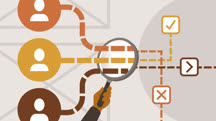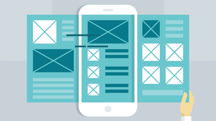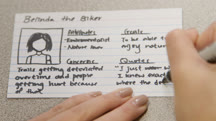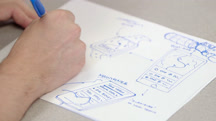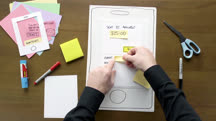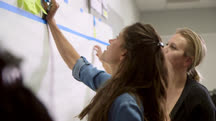Course catalog
Categories
Showing 8,481-8,500 of 9,135 items.
Using Wacom Tablets with Painter
Maximize the expressive capabilities of your digital painting toolset. Learn to integrate a Wacom tablet and stylus for maximum pressure sensitivity and range of motion.
Using Wacom Tablets with Photoshop
Optimize your Wacom tablet for use with Adobe Photoshop and get finer control when drawing and painting.
UX Deep Dive: Analyzing Data
Take a deep dive into best practices and methodologies for analyzing data to inform and guide your UX design projects.
UX Deep Dive: Foundational Research (223972)
When it comes to UX research, there are two major categories: evaluating what’s already been done, or exploring and defining unknown spaces. Evaluative work is great, but if you’re starting from scratch or trying to figure out who your users are, you’re going to need to turn to foundational research, which involves the exploration of users, contexts, or possibilities. This approach can help you understand what you should be building and for whom.
In this course, Amanda Stockwell guides you through the ways foundational research can help uncover new opportunities and areas for improvement, regardless of your current state. Amanda starts by describing what foundational research is and how it differs from evaluative research in UX. She then covers different forms of foundational research like ethnography, data mining, and market research. Much as you wouldn’t start building a house from the third floor, building a strong foundation to your UX research will bolster every step going forward.
In this course, Amanda Stockwell guides you through the ways foundational research can help uncover new opportunities and areas for improvement, regardless of your current state. Amanda starts by describing what foundational research is and how it differs from evaluative research in UX. She then covers different forms of foundational research like ethnography, data mining, and market research. Much as you wouldn’t start building a house from the third floor, building a strong foundation to your UX research will bolster every step going forward.
UX Deep Dive: Mapping
Take a deep dive into the project mapping types that can help inform and shape your user experience (UX) design projects.
UX Deep Dive: Remote Research (224448)
When your job as a UX researcher is entirely based on learning about people and their behaviors, how do you adjust when you can’t conduct research in person? In this course, research expert Amanda Stockwell details the keys to conducting remote UX research, from recruiting participants—and making sure they show up—to planning, preparing, running and remote sessions. Amanda covers the benefits of conducting your UX research in a virtual environment, as well as situations where a more traditional research approach would be beneficial. Having a command of remote methods in addition to in-person research practices will help you conduct your work effectively, regardless of the situation.
UX Deep Dive: Usability Testing
Take a deep dive into usability testing techniques and methodologies for user experience (UX) design projects.
UX Design for Developer Tools
Learn how to design a developer-focused tool by examining the UI in the Pixel Vision 8 game console.
UX Design for Developers
Learn how to create intuitive, elegant UX designs that delight users. Discover an entry point to the principles and process of UX design for typical business apps.
UX Design: 1 Overview
Learn about the set of user-centered design techniques that are covered in the UX Design Techniques series.
UX Design: 2 Analyzing User Data
Learn how to gather user data and transform that data into actionable project ideas for more user-centric UX designs.
UX Design: 3 Creating Personas
Make your development process more user-centered with personas. Learn about the importance of user personas, how to create them, and how to use them in your UX research and design.
UX Design: 4 Ideation
Learn to incorporate ideation techniques in your design workflow. Leverage the input from your team to create the best possible product and to ensure a good user experience.
UX Design: 5 Creating Scenarios and Storyboards
Identify design gaps and the exact features you need to build to make your users happy. Learn how to write scenarios and create storyboards in this installment of the series.
UX Design: 6 Paper Prototyping
Learn how to get fast, inexpensive, and early validation of your design ideas using simple materials—pen and paper.
UX Design: 7 Implementation Planning
Head into development with a clear understanding of what you need to build. Learn how user-centered design (UCD) artifacts can help you create a precise implementation plan.
UX DesignOps: Overview (231588)
Learn the basics of UX DesignOps: integrating a design team into an agile, business-driven development process. DesignOps is a human-centered approach to better planning and collaborating using an iterative agile approach that helps a design or product team scale become more successful. This course provides an overview of the practice, from designing better workflows to scaling your UX team, Plus, learn how to work effectively with developers and stakeholders and measure your success. Instructor and UX expert Dee Sadler follows a successful UX department through the DesignOps process and explains all the interdependencies and communication channels needed to make it work efficiently—every step of the way.
UX DesignOps: Working with Developers (219467)
While UX teams typically work well with product teams, it’s a little less intuitive when UX teams must work closely with developers. A lot of the troubles that arise when UX and developer teams work together are the result of the teams not knowing enough about what each team does. That’s where DesignOps comes in. DesignOps can take the unknowns out of the equation by creating a UX process and making sure there is consistency in the handoff of deliverables. In this course, Dee Sadler teaches you the basics of UX DesignOps, covering the process of interfacing with business and strategy departments alongside developers in an agile process. Dee outlines the steps a successful UX department follows and the interdependencies and communication channels needed to make it work efficiently. After this course, you’ll have a better idea of the benefits UX teams and developer teams can both reap by working closer together, and how DesignOps helps facilitate better interaction.
UX for Small Business Websites
What makes a great small business website? Find out how to design a great user experience for the customers of your small business.
UX for Voice: Planning and Implementation
Learn how voice-activated artificial intelligence can enhance a user experience, and how to plan and implement voice interactions on modern devices.






